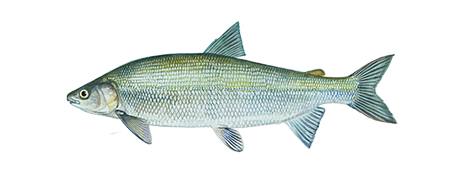
Lake Whitefish
The lake whitefish is more highly regarded as a game fish than the other whitefishes. The flavor is considered supreme.

Region
Midwest, Northeast, West
Catch ease
Easy
Habitat
Lake, River, Pond
How to identify a Lake Whitefish
The lake whitefish is a member of the salmon family, as can be noted by the presence of the adipose fin and pelvic axillary process. Overall coloration is silvery to satiny white with olive to pale greenish brown on the back. The back may be dark brown to black in some inland lake specimens. The mouth is subterminal and the snout protrudes beyond it. Because the head is small in relation to the length of the body, older fish may develop a hump behind the head; thus the name “humpback.” The lake whitefish has more pyloric caeca, 140-222, than either the round, with 50-130, or mountain lakefish which has 50-146. The body is more laterally compressed than the round or mountain whitefish, which belong to a group referred to as “round whitefishes”.
Where to catch Lake Whitefish
The lake whitefish is found throughout Canada and Alaska and into the extreme northeastern portions of the United States, throughout the Great Lakes as well as from New York to Maine. Transplanted populations exist in Washington, Idaho, and Montana in the northwestern United States. The lake whitefish is much more widespread and attains a much larger size than either the mountain whitefish or the round whitefish. The following list includes additional details on where to catch this fish:
| Cliffs and Steep Shore Banks |
| Holes |
| Open Water |
| Rivers and Streams |
| Rocks |
| Drop-Offs |
| Undercuts |
| Freshwater Lakes and Ponds |
| Islands or Sand Bars |
| Overhanging Trees and Bushes |
| Rock and Boulder Pockets |
| Dams and Falls |
| Spring Holes |
How to catch Lake Whitefish
Primarily bottom feeders, theses fish can be taken with spinning, bait casting or fly tackle and will strike small spoons, jigs and other baits. Natural baits like insects, fish eggs, and small baitfish will also work. The following are fishing methods used to catch this fish:
Lake Whitefish lures, tackle & bait
The following are lures, tackle or bait that can be used to catch this fish:
